In 2013, two cavers entered the Rising Star Cave System of South Africa. They crawled through the tiny corridors and up on top of the Dragon’s Back, a nearly fifty foot tall block of dolomite which had fallen from the ceiling. From the top, they peered down into a deep black pit. Then they began to descend down the vertical eight inch wide shaft. Forty feet down, their boots hit something solid, a sloping pile of debris. The narrow chute opened up into a series of cavernous chambers. When their flashlight beam swept across the cave floor, it revealed a secret thousands of years old. Bone fragments, scattered across the surface. Pieces of a skull jutted out of the earth and tiny limb bones lay exposed on the dusty ground.
The views expressed in this article reflect those of the author mentioned, and not necessarily those of New Creation.
Paleoanthropologist Lee Berger led an excavation to the cave that November. In 2015, his team published their findings.1 They had uncovered thousands of fragmentary bones belonging to a new species, Homo naledi. Now, further excavations have yielded evidence that this species may have been engaging in complex behaviors like burial, tool use, and engraving. Are these claims accurate, and what can they tell us about Homo naledi?
Who Was Homo naledi?
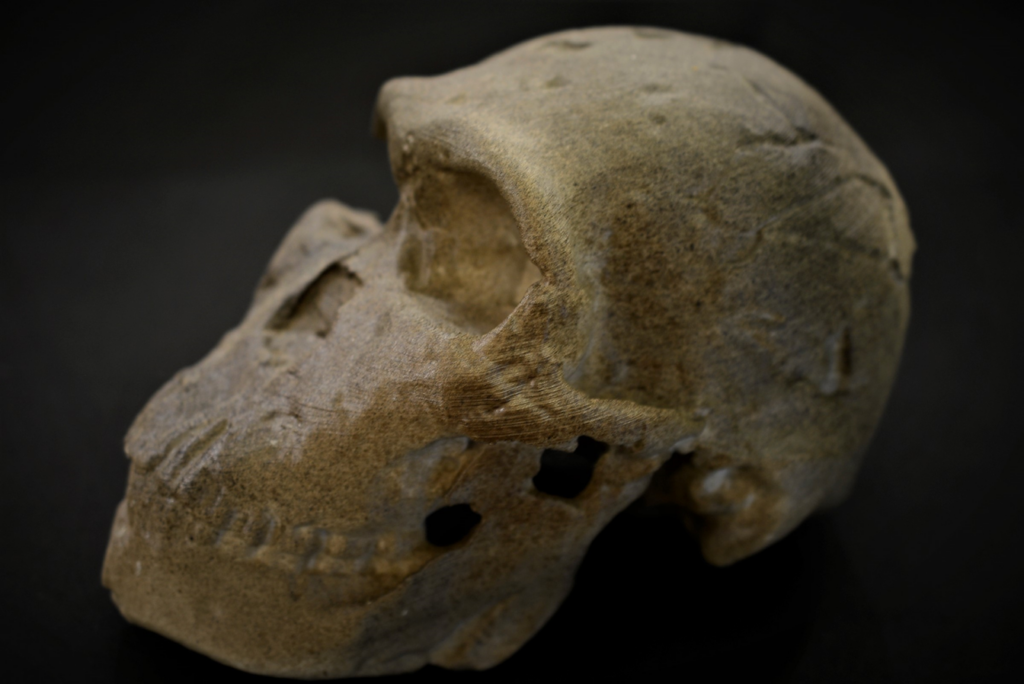
The identity of Homo naledi has been a source of controversy since its discovery. Some of the “primitive” features which appear in this species led the conventional scientific community to believe the species could be millions of years old. However, dating of the fossils revealed that they lived much more recently.2 In fact, they were contemporaries of our own species: Homo sapiens. Where Homo naledi falls on the human family tree is a source of disagreement. Some scientists believe that it is only very distantly related to living humans, being one of the very earliest branches.3 Other researchers argue that it is a later branch, and is more closely related to us.4
Was Homo naledi Caching Bodies?
Scientists soon began to wonder how Homo naledi traveled back into the Dinaledi Chamber, where they discovered the majority of fossils. Today, only the most adventurous of cavers undertake this trip. The first major obstacle is Superman’s Crawl, a ten inch high passageway. To get through, most people must lay down on their stomach, turn their head sideways, and place one arm out in front. Once past this obstacle, you must climb fifty feet up the Dragon’s Back and squeeze forty feet down a vertical shaft. Despite being smaller than modern humans, Homo naledi would also have had a difficult time navigating these passages.
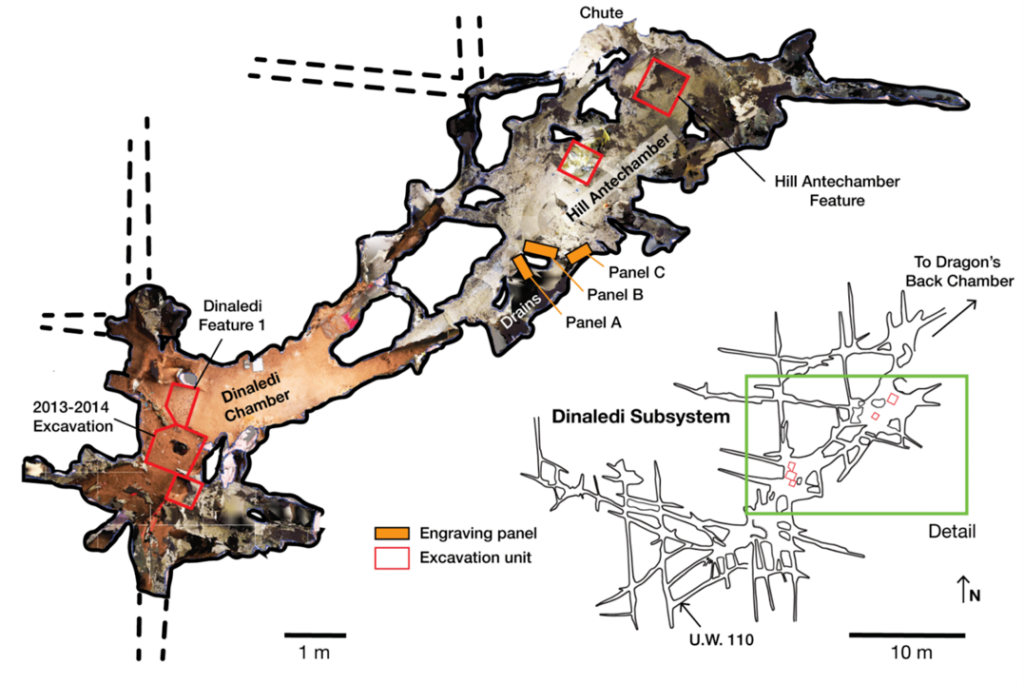
Berger’s team suggested a radical idea. Perhaps Homo naledi had intentionally entered the cave. What if they were depositing dead bodies in the Dinaledi Chamber?5 This scenario would explain the remote placement of the bodies and why there was no evidence of flooding or predation. It would also make sense of the temporal extent of the bodies. Homo naledi may have been returning to the cave for successive generations to deposit their dead.
Berger and his colleagues now believe that they have evidence which demonstrates that Homo naledi was not only depositing bodies in the cave, they was burying them. They have also presented evidence that Homo naledi was carving on the cave walls and possibly using stone tools. However, as preprints, the contents of these papers have not yet undergone peer review. As a result, some of the information and interpretations which they contain could change.
The Hill Antechamber Feature
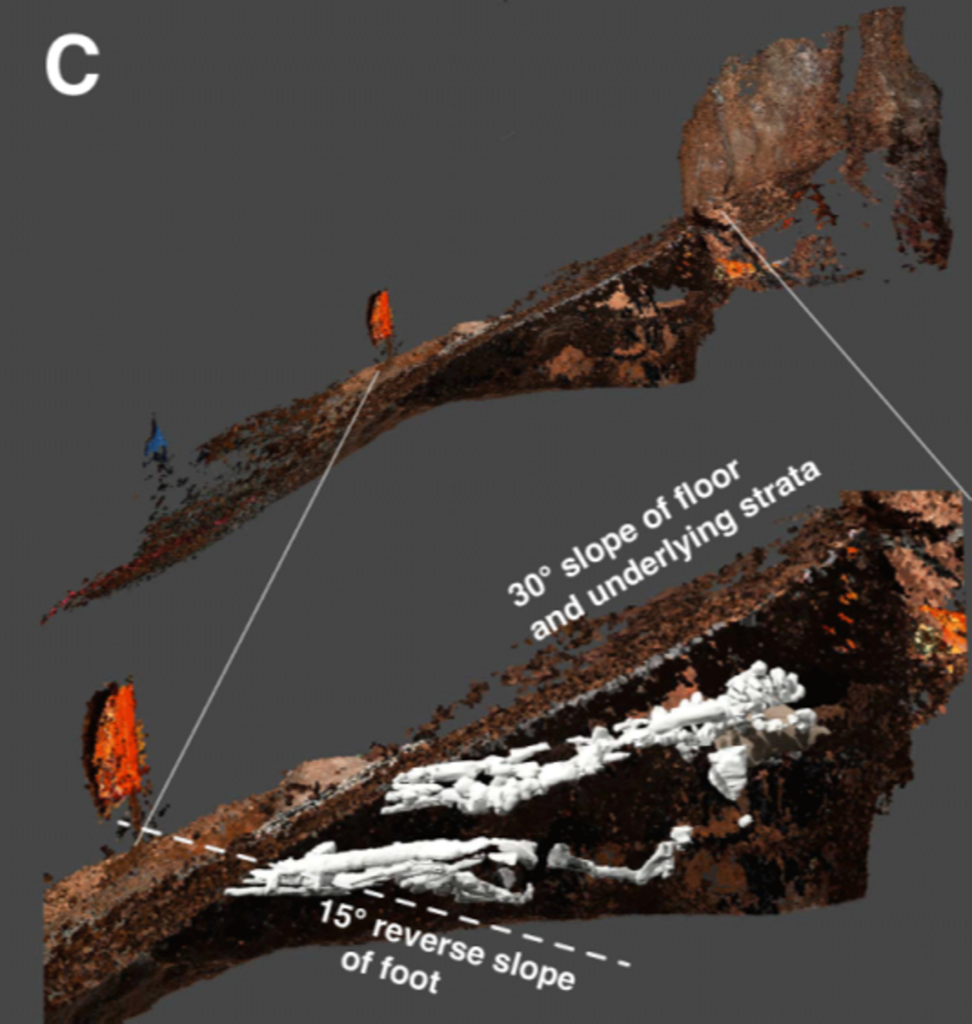
In 2017 Berger and his team discovered the first of the alleged burials.6 They began to excavate in a room called the Hill Antechamber, which lies at the bottom of the vertical shaft mentioned previously. Directly underneath the shaft is a debris cone, a pile of sediment which fell down from above. Only centimeters below the sloping surface, the team uncovered a concentration of bones. They dug around the sides of the feature, cleaved it into multiple pieces, and covered it in plaster for removal from the cave. The team took the blocks out of the cave, but they have not yet removed the plaster that surrounds them. Scientists CT scanned the feature to determine its contents.
Scans revealed that the feature contained at least fifty one teeth and ninety bones. Thirty of the teeth belong to a single Homo naledi, referred to as Individual 1. Many of this individual’s teeth remain preserved in place next to each other. Study of the wisdom teeth reveals that they had not yet finished developing, meaning that the individual is a juvenile. The team believes that nearly all of the skeletal remains within the feature belong to Individual 1. They infer this because there were no bone duplicates, and their spatial arrangement might be consistent with them coming from a single individual. Some parts of this skeleton, such as the right hand and foot, are articulated. This means the bones still fit together as they did when the individual was alive.
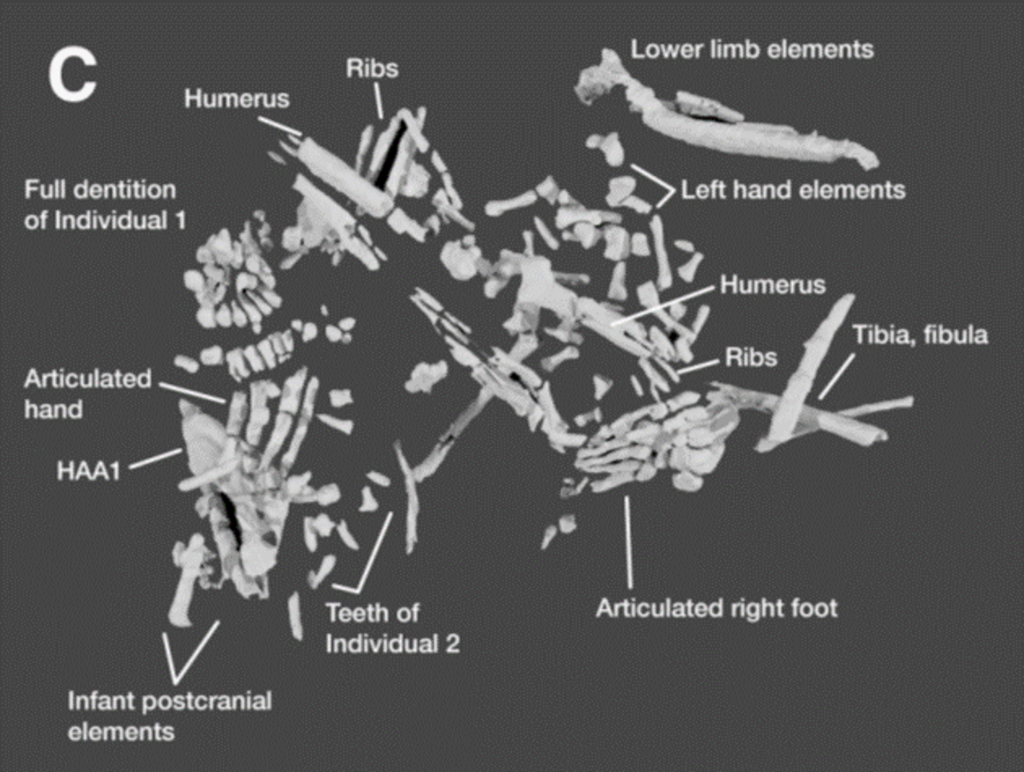
However, there are a few skeletal remains within the Hill Antechamber Feature which come from other Homo naledi individuals. Fourteen of the teeth come from a second juvenile individual. This individual’s teeth are not arranged in anatomical position. They rest scattered within a ten centimeter area. An additional four teeth come from a third individual. The researchers believe a few small, undeveloped teeth and unidentified limb bones came from a fourth very young individual.
Observations in Support of a Burial
There are a few interesting observations which may point to this feature being a burial:
First, the main skeletal elements may come from a single individual. Berger claims that the skeleton may have been buried in a fetal-like position. However, more research is necessary to demonstrate this with any certainty. Researchers cannot see certain skeletal elements such as vertebral and pelvic remains within the feature. To the CT scanner, skeletal elements which have a thin layer of cortical bone may be “invisible”. Preparation of the feature may reveal further bones which will help with the reconstruction of burial position.
Second, the body came to rest at its present location soon after death. Flesh must still have covered parts of the body, such as the hand and foot, to keep the bones from becoming disarticulated. In a burial scenario, this means that the individual’s burial happened soon after their death. However, in an alternate scenario, this places limitations on the amount of time between the individual’s death and burial.
Third, the body came to rest in a pit. If the body had simply decomposed on the surface of the debris cone, the bones should fall along the plane of the slope. Instead, what we find is that the lower limb is on a plane which is angled differently than the slope. This suggests that the body came to rest within the slope, but on a separate plane than the surface. The surrounding stratigraphy also supports the conclusion that the body was in a pit. The sedimentary layers show clear evidence of disruption around the body. Around the body is a thin, disturbed layer of orange rock fragments. Underneath the skeleton, they form a concave surface, riddled with air pockets.
Fourth, sediment may have covered the body in two rapidly succeeding events. The bones within the feature are concentrated in two layers. Researchers found parts of the lower limb and left arm in the lowest part of the feature. A layer of sediment seems to separate these from the other bones. This seems to suggest that the lower body and lower left arm were covered first, then the upper body and right arm were folded over on top. If this is indeed the case, it would be a very odd burial position. However, it would also be difficult to explain outside of a burial.
The Hill Antechamber “Artifact”
CT scans of the Hill Antechamber Feature revealed that it contained more than just bones. An oddly shaped rock sits neatly among the hand and wrist bones of Individual 1. The rock is relatively flat and long, with a tapering point at one end. The stone possesses a distinctive curve because of the removal of a semicircular flake of rock from its side. Berger and his colleagues argue that the rock is different in shape than any others found within the cave. Apparently, it is the only substantially-sized stone found within the Hill Antechamber Feature.
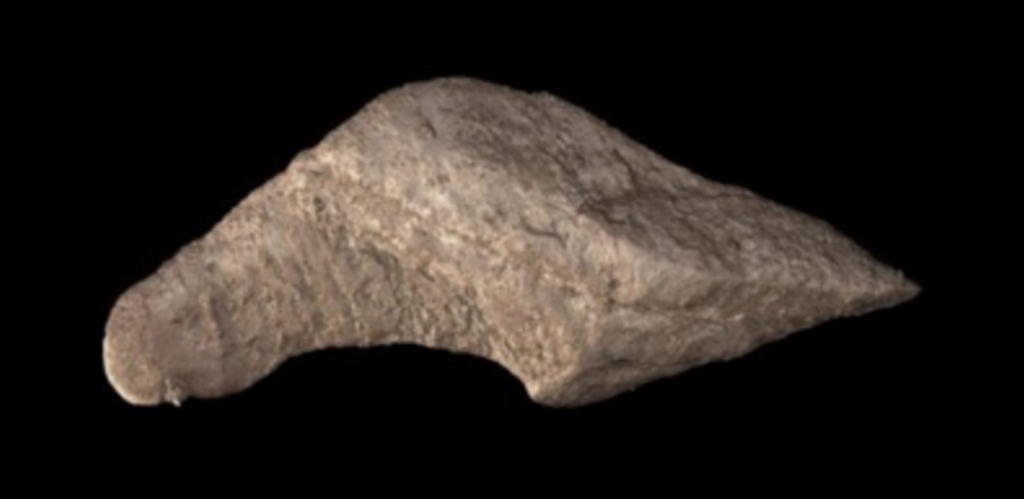
Berger refers to the rock as an “artifact” and a “tool-shaped rock”. This seems to allege either that Homo naledi intentionally shaped it, or that they utilized a naturally shaped rock. The presence of the rock among the hand bones of the Homo naledi skeleton has led some to speculate that it could be an example of a grave good.
Closer Examination
Until researchers extract the stone from the feature, its status as an artifact will likely remain unclear. What is clear is that the “artifact” is not very complex. The shape of the rock has not demonstrated it required intentional modification. It may be necessary to microscopically analyze the wear patterns on the stone. This could help determine whether it was used in any way. It is still unknown what type of rock the “artifact” is. The team hypothesizes that it may be a piece of dolomite, in which case it could be sourced directly from the walls of the cave.
Demonstrating that the stone is a grave good would be quite difficult. Even if one accepts the Hill Antechamber Feature as a burial, the “artifact” may not be a grave good. While burying Individual 1, Homo naledi could have accidentally included the stone in the soil used to cover the body. If this was the case, the association with the hand must be purely random. Alternatively, the “artifact” could be a grave good even if Homo naledi neither shaped nor used it. The unique shape of the rock or some aspect of its color could have made it a suitable item to bury with the deceased.
The Dinaledi Features
In 2018, the team began an new excavation within the Dinaledi Chamber. Just eight centimeters below the surface they found a small concentration of bones, Dinaledi Feature 1. Twenty centimeters to the west they uncovered another, smaller concentration of bones, Dinaledi Feature 2.
Dinaledi Feature 1 is a roughly oval area which appears to contain a single, adult Homo naledi skeleton. So far, researchers have found eighty three bones and teeth on top of and inside the feature. They also found a small number of bones belonging to a juvenile individual sitting atop the main cluster. The feature which contains the bones is roughly horizontal, in contrast to the slightly angled cave floor above. This feature also seems to interrupt the stratigraphy of the cave floor. A thin layer of orange mud clasts forms a horizontal band on either side of the feature. Within the feature, however, the orange clasts are mixed up and not aligned in a layer. These pieces of evidence suggest that the bones came to rest within a pit.
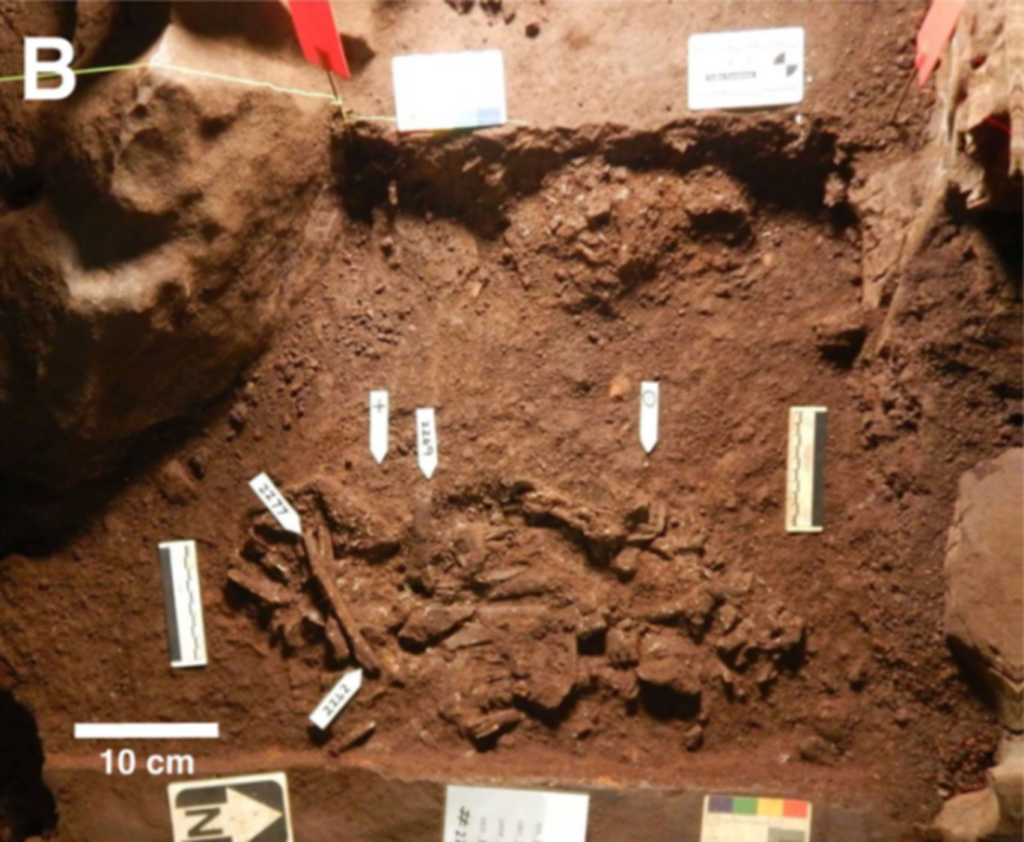
Researchers have yet to extract Dinaledi Feature 1 from the cave. As a result, CT scans of the feature are not available. Scientists are only able to observe the bones on the upper surface of the feature. Their spatial configuration might be consistent with the body laying on its side in a fetal-like position. Berger hypothesizes that the collapse of the abdominal and pelvic cavities may have caused a sediment collapse which pulled the juvenile remains from above. More research is necessary to document the positions of the various bones and determine why some of them seem to be out of place.
The Engravings
Last July, the team discovered unique markings on the walls of the Hill Antechamber.7 The markings are located at the mouth of one of the passages which leads from the Antechamber into the Dinaledi Chamber. Etched within the dolomite walls and on a cave pillar are a series of scratches. Many of the marks are straight lines which intersect to form a variety of shapes. Some look similar to a hashtag or pound symbol, others look like triangles, X’s, and other shapes.
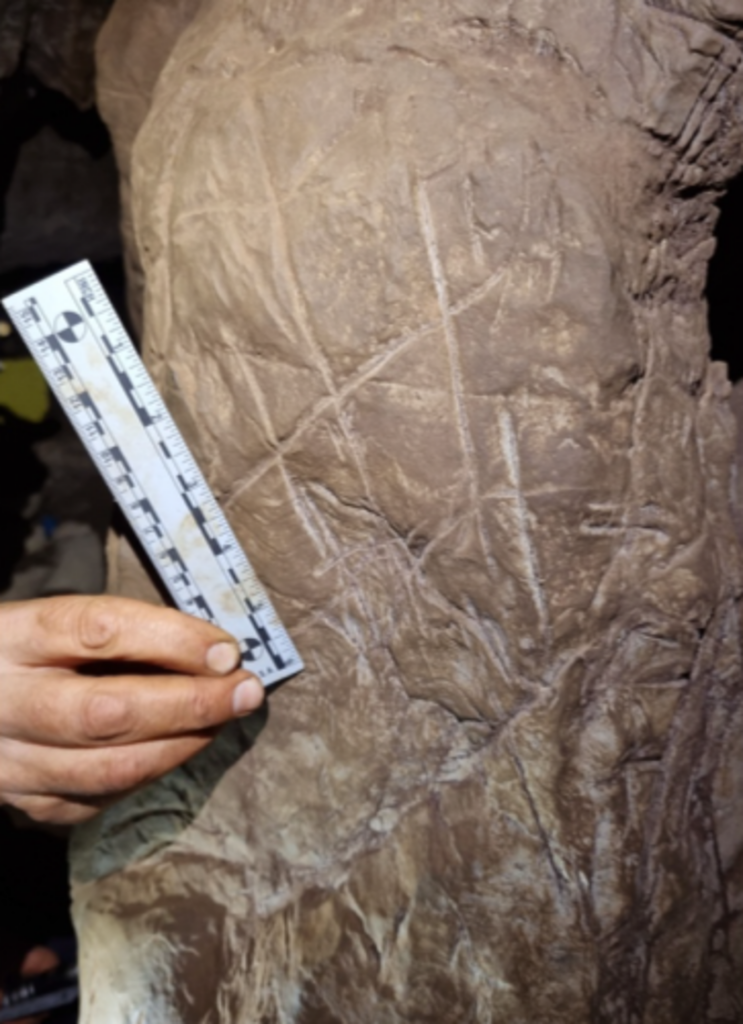
The team believes that the cave walls were prepared before engraving. The surfaces on which they found the engravings appear discolored. They believe that tiny fractures on the rock walls are evidence that the engravers hit the wall repeatedly, chipping off pieces of stone to make a flatter surface. Supposedly, the engravers rubbed sand across the wall, perhaps to further polish it. The engravings may have been created by repeatedly dragging a pointed stone across the surface. Then, sand might have been rubbed over the surface a second time. This may have filled the grooves in the dolomite, making them more clearly visible. Some of this material still adheres to the rock as a residue which is present in some of the grooves of the engravings. Berger’s team has plans to sample and test the material.
Dating
While it seems like Berger might have a case that the markings were intentionally made, it will be difficult to definitively attribute them to Homo naledi. There is no skeletal evidence that Homo sapiens or any other large brained humans entered the cave until recently, making Homo naledi the most likely candidate. But, in order to more conclusively attribute the engravings to Homo naledi, it would be necessary to date them.
Unfortunately, the team has not yet attempted to date the engravings. As a result, we do not yet know if they were created at the time when Homo naledi was still alive. Berger points out that while we have a maximum age for the Homo naledi material within the cave, we do not have a minimum date. As a result, we don’t really know when they last entered the cave. So, unless the engraving is very recent, it could hypothetically still have been made by late surviving Homo naledi individuals.
Conclusion:
These new discoveries are incredibly exciting, and may give us a glimpse of Homo naledi’s behavior. A lot of work still remains, from extraction of the Dinaledi Features to dating of the engravings. Perhaps the hardest job will be convincing the paleoanthropological community that the team’s interpretation is right. However, if Berger is correct, the implications of these findings go far beyond just Homo naledi. In part two of this review, we’ll examine what these findings might tell us about Homo naledi, and the nature of humanity.
Footnotes
- Berger et al. 2015. Homo naledi, a new species of the genus Homo from the Dinaledi Chamber, South Africa. eLife, 4:e09560. DOI: 10.7554/eLife.09560 ↩︎
- Dirks et al. 2017. The age of Homo naledi and associated sediments in the Rising Star Cave, South Africa. eLife, 6:e24231. DOI: 10.7554/eLife.24231 ↩︎
- Davies et al. 2020. Distinct mandibular premolar crown morphology in Homo naledi and its implications for the evolution of Homo species in southern Africa. Sci Rep, 10,13196. DOI: 10.1038/s41598-020-69993-x ↩︎
- Dembo et al. 2016. The evolutionary relationships and age of Homo naledi: An assessment using dated Bayesian phylogenetic methods. Journal of Human Evolution, Vol. 97, Pg. 17-26. DOI:10.1016/j.jhevol.2016.04.008 ↩︎
- Dirks et al. 2015. Geological and taphonomic context for the new hominin species Homo naledi from the Dinaledi Chamber, South Africa. eLife, 6:e24231. DOI: 10.7554/eLife.24231
↩︎ - Berger et al. 2023. Evidence for deliberate burial of the dead by Homo naledi. bioRxiv 2023.06.01.543127. DOI: 10.1101/2023.06.01.543127 ↩︎
- Berger et al. 2023. 241,000 to 335,000 Years Old Rock Engravings Made by Homo naledi in the Rising Star Cave system, South Africa. bioRxiv 2023.06.01.543133. DOI: 10.1101/2023.06.01.543133 ↩︎

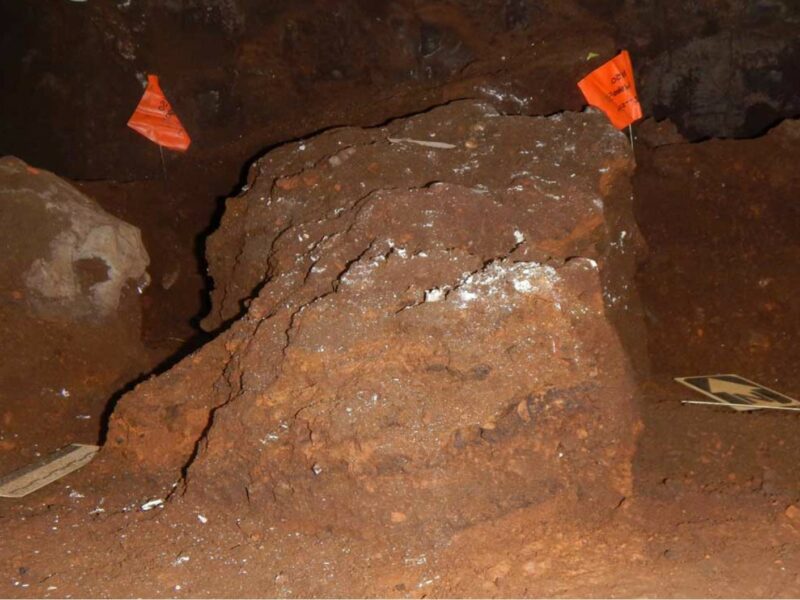
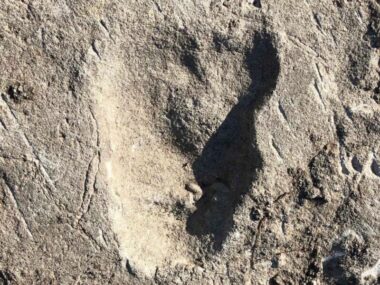
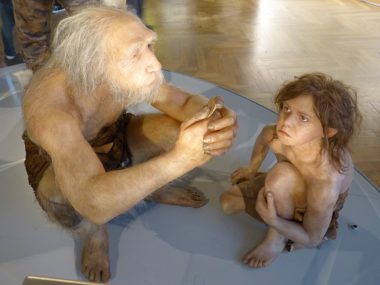
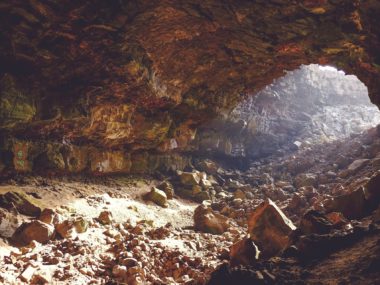
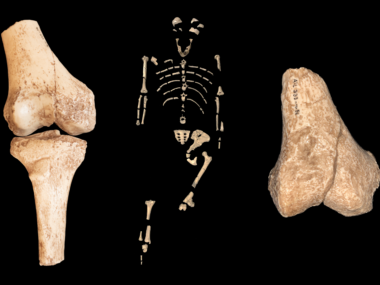
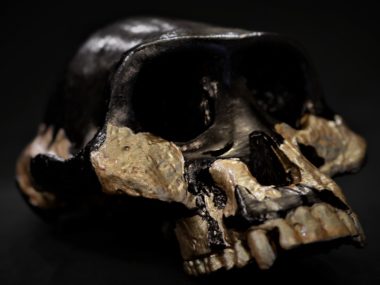


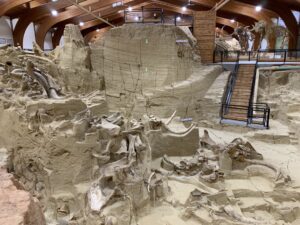


They seem like they might be interesting little guys. I didn’t realize that the engravings were so complex. It did make us wonder why they did this, what it meant to them.